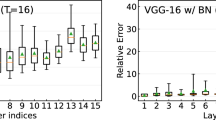Abstract
A revised recurrent neural networks method for the passive source localization is proposed in this paper. The cost function has been designed which makes the transformation from transmitters’ localization into the outputs of the settled revised recurrent neural networks through spatial partition. The neural networks are chaotic and stable in convergence. The received signal model is constructed firstly. The parameters of the recurrent neural networks have been trained properly according to the scene. The experiments and analysis display that the revised recurrent neural networks solution not only obtains high precision location, but also has high convergence rate.




Similar content being viewed by others
References
Torrieri DJ (1984) Statistical theory of passive location systems. IEEE Trans Aerosp Electron Syst AES-20(2):183–198. https://doi.org/10.1109/TAES.1984.310439
Tirer T, Weiss AJ (2017) Performance analysis of a high-resolution direct position determination method. IEEE Trans Signal Process 65(3):544–554. https://doi.org/10.1109/TSP.2016.2621729
Oispuu M (2009) Direct state determination of multiple sources with intermittent emission. In: 2009 17th European signal processing conference, 24–28 Aug 2009, pp 1948–1952
Weiss AJ, Amar A (2005) Direct position determination of multiple radio signals. EURASIP J Adv Signal Process 1:1–13
Takeda R, Komatani K (2016) Sound source localization based on deep neural networks with directional activate function exploiting phase information. In: 2016 IEEE international conference on acoustics, speech and signal processing (ICASSP), 20–25 March 2016, pp 405–409. https://doi.org/10.1109/icassp.2016.7471706
Gotsis KA, Kyriacou GA, Sahalos JN (2009) Improved neural network doa estimation for a switched-beam system in a multipath DS-CDMA scheme. In: 2009 3rd European conference on antennas and propagation, 23–27 March 2009, pp 186–190
Christodoulou C, Georgiopoulos M (2001) Applications of neural networks in electromagnetics. Artech House, Inc
Jin L, Li S, Luo X, Li Y, Qin B (2018) Neural dynamics for cooperative control of redundant robot manipulators. IEEE Trans Industr Inf PP(99):1–1
Jin L, Li S (2016) Distributed task allocation of multiple robots: a control perspective. IEEE Trans Syst Man Cybern Syst PP(99):1–9
Li S, Zhou MC, Luo X (2017) Modified primal-dual neural networks for motion control of redundant manipulators with dynamic rejection of harmonic noises. IEEE Trans Neural Netw Learn Syst 99:1–11. https://doi.org/10.1109/TNNLS.2017.2770172
Popov AV, Sayarkin KS, Zhilenkov AA (2018) Analysis of perspective models of artificial neural networks for control of robotic objects. In: 2018 IEEE conference of Russian young researchers in electrical and electronic engineering (EIConRus), 29 Jan 2018–1 Feb 2018, pp 958–961. https://doi.org/10.1109/eiconrus.2018.8317248
Gotsis KA, Siakavara K, Sahalos JN (2009) On the direction of arrival (DoA) estimation for a switched-beam antenna system using neural networks. IEEE Trans Antennas Propag 57(5):1399–1411. https://doi.org/10.1109/TAP.2009.2016721
Stanković Z, Dončov N, Milovanović B, Russer J, Milovanović I (2014) Neural network approach for efficient DOA determination of multiple stochastic EM sources in far-field. In: 2014 international conference on numerical electromagnetic modeling and optimization for RF, microwave, and terahertz applications (NEMO), 14–16 May 2014, pp 1–4. https://doi.org/10.1109/nemo.2014.6995724
Ying T, Chao D, Zhenya H (1997) A chaotic annealing neural network and its application to direction estimation of spatial signal sources. In: Neural networks for signal processing VII. Proceedings of the 1997 IEEE signal processing society workshop, 24–26 Sep 1997, pp 541–550. https://doi.org/10.1109/nnsp.1997.622436
Wu ZG, Shi P, Su H, Chu J (2014) Local synchronization of chaotic neural networks with sampled-data and saturating actuators. IEEE Trans Cybern 44(12):2635–2645. https://doi.org/10.1109/TCYB.2014.2312004
Zhu H, Jia Z, Peng H, Li L (2007) Chaotic ant swarm. In: 3rd international conference on natural computation (ICNC 2007), 24–27 Aug 2007, pp 446–450. https://doi.org/10.1109/icnc.2007.296
Balavoine A, Romberg J, Rozell CJ (2011) Convergence and rate analysis of neural networks for sparse approximation. IEEE Trans Neural Netw Learn Syst 25(8):1595–1596
Author information
Authors and Affiliations
Corresponding author
Additional information
Publisher's Note
Springer Nature remains neutral with regard to jurisdictional claims in published maps and institutional affiliations.
Rights and permissions
About this article
Cite this article
Zhao, C., Zhao, Y. One Recurrent Neural Networks Solution for Passive Localization. Neural Process Lett 49, 787–796 (2019). https://doi.org/10.1007/s11063-018-9856-y
Published:
Issue Date:
DOI: https://doi.org/10.1007/s11063-018-9856-y




